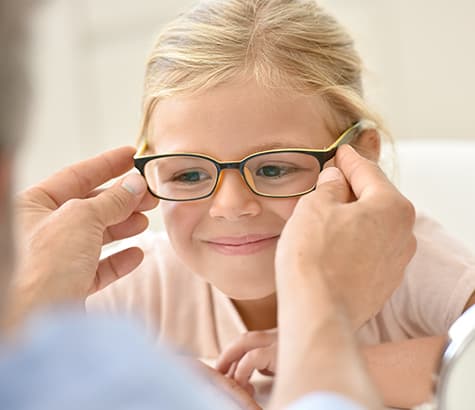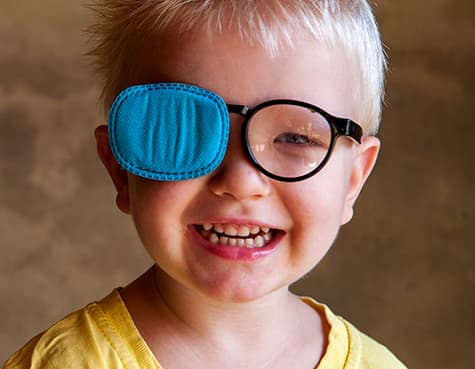Good vision plays an important role in children’s well-being. It is critical to their learning, interactions and development.
Children don’t always know that they are having a problem with their vision. – They may assume that everyone sees the way that they do.
What Signs and Symptoms Should Parents Watch for In Their Child?

- Child describes blurriness or double vision
- Trouble reading or doing close-up work
- Eyes appear misaligned
- Learning difficulties in school
- Tilting the head or turning to one side
- Repeatedly squinting or keeping one eye closed
- Red, crusty, or swollen eyelids
- Frequently rubbing eyes
- Frequent headaches
- Sitting too close to the TV
What is Vision Screening and Who Performs it?
Vision screening should occur throughout childhood. There is a better chance of successful treatment when an eye problem is detected early.
The first vision screening is performed by a pediatrician who checks the baby’s eye, pupil and red reflex. This is the reflection from the back of the eye.
Pediatricians or nurse practitioners often complete vision screenings. These are part of regular well child office visits.
Vision screenings may also be done at day care centers, schools, and community centers.
There are a variety of methods to perform vision screening. They usually depend on the child’s age and ability to cooperate:
- Examination of the eye, pupil and red reflex with a flashlight and ophthalmoscope. The practitioner looks for irregular shapes and structures, as well as pupil abnormalities.
- Photoscreening to test for the need for glasses and other abnormalities
- Corneal Light Reflex Testing with a penlight
- Cover testing -covering each eye to look for misalignment
- Visual acuity testing with an eye chart is for children aged 3 or older. Shapes or symbols are often substituted for letters.
When Should Children Have a Comprehensive Eye Exam?
Vision screening does not detect all vision problems. If your child fails a vision screening, they should have an evaluation with an ophthalmologist. Comprehensive eye exams are also needed for children with:
- Significant prematurity
- Systematic conditions or diseases that may affect vision
- Family history of juvenile cataracts, juvenile glaucoma
- Developmental delays or learning issues that may be related to poor vision
- Strong family history of childhood eye conditions such as amblyopia or strabismus
How Do Eye Doctors Perform Comprehensive Eye Exams on Children?
Children’s eye exams are very different from adult exams. Doctors can’t rely on children to describe what they are seeing or experiencing.
For this reason, they need to use objective measurements. An example would be shining a light into the back of the eye to assess vision capability.
The eye doctor will tailor the exam to the age and ability of the child. The goals are to:
- Measure clarity of vision
- Assess eye alignment and eye movements
- Check for refractive errors (nearsightedness, farsightedness, and astigmatism)
- Look at the health inside and outside the eye. (Looking inside the eye usually requires dilating the child’s pupils with eye drops.)
Common Eye Conditions In Children
 Children can have focusing problems, poor depth perception, and color blindness. This is besides refractive errors like nearsightedness, farsightedness, and astigmatism.
Children can have focusing problems, poor depth perception, and color blindness. This is besides refractive errors like nearsightedness, farsightedness, and astigmatism.
What is Strabismus?
Strabismus is any type of misalignment of the eye. It is a common condition among children, affecting about 4% of the U.S. population.
It usually involves problems with muscle control of the eye. There are four common types:
- Esotropia – inward turning of the eyes
- Exotropia -outward turning of the eyes
- Hypertropia -abnormal eye is higher than the normal eye
- Hypotropia -abnormal eye is lower than the normal eye
Different kinds of strabismus need different treatments. These include glasses, exercises, prisms, eye muscle surgery, and eye muscle injection.
What is Ambylopia?
Ambylopia (“lazy eye”) is a type of strabismus. It occurs when vision in one eye isn’t as good as the other. This happens because the brain and the eye are not functioning together. The eye may look normal, but it is not functioning properly.
Using an eye patch on the stronger eye can be a very effective method of treating amblyopia.
Pediatric Eye Care in London, Somerset, and Lexington, Kentucky
When it comes to your children’s eyes, you need to know you can trust their eye doctor. At Huffman & Huffman, P.S.C. we take pediatric eye care seriously.
Every patient receives the same level of care from our board-certified doctors. Schedule an appointment at Huffman & Huffman, P.S.C. in London, Somerset, and Lexington, KY today!
